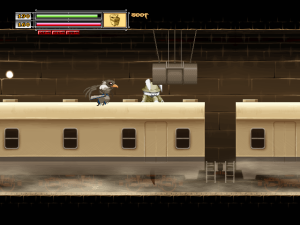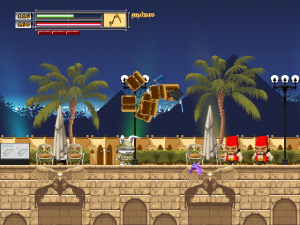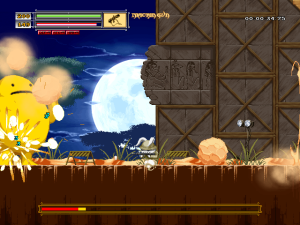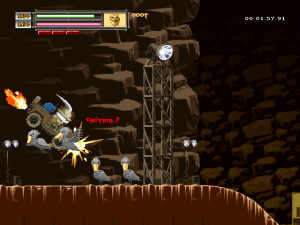Official Site (Japanese) || Steam Page
Pharaoh Rebirth+ by Krobon Station is not quite a Metroidvania and it’s not quite a standard action platformer either, but it is a whole lot of fun. Players take control of Jonathan, an archaeologist transformed into a rabbit by a curse, as he rushes across Egypt in an attempt to collect seven holy grails and break another, deadlier curse caused by accidentally reviving Sehur the First, the pharaoh in question in this game’s title. There’s a lot to like about Pharaoh Rebirth+ so let’s get started!
Its world may be divided into slightly more than half a dozen stages, but that hardly means that Pharaoh Rebirth+ is lacking a sense of exploration. Similar to Castlevania: Order of Ecclesia, the stages aren’t physically connected to each other, yet each is about as large and open as a single region in most Metroidvanias. In fact, many of the dozens upon dozens of optional collectibles within these stages can only be obtained after finding a power-up or two from a later stage. The disconnected nature of the stages even serves as one of Pharaoh Rebirth+’s greatest strengths as, on top of cutting down on backtracking time, it allows for the inclusion of dynamic and diverse environments. Yes, Jonathan spends plenty of time running through various ancient ruins on his adventure, but he also boards a ghost train, rides a car through a mine, and even visits a fancy Egyptian hotel along the way.

Collecting stuff is a pretty big part of the Pharaoh Rebirth+ experience. Before delving any further into the subject, I would like to put any potential fears at ease by stating that revisiting old stages is entirely optional; any items which grant mandatory abilities are needed in order to complete the stages in which they are found so you can finish the game and never bother with replaying stages unless you want to. Of course, if you only focus on rushing to the end of this game you’ll miss out on plenty of flavor text, a good number of fun conversations between Jonathan and various NPC’s, and some of the trickiest platforming the game has to offer (not to mention you’ll probably die rather often as Pharaoh’s Rebirth+ doesn’t exactly pull its punches when it comes to difficulty). As for the collectibles themselves, each stage has four mysterious golden fragments to find and generally around a dozen or so other items. Several of these items give passive stat boosts, but many of them serve some other purpose, such as combining into a map, granting access to new subweapons (more on those later), allowing Jonathan to revive with a small amount of HP after dying, or just being necessary in order to acquire some other, more useful item.

Since you need to backtrack through old stages with new abilities to acquire a significant number of items, the actual act of exploration and item collection could have turned into a tiresome slog, but Pharaoh Rebirth+ does a great job of cutting down on and eliminating the worst parts of this process. Save points are frequent and fully restore Jonathan’s HP and MP, so you never lose much progress upon getting a Game Over, and you can choose to exit a stage from the menu at any time without losing the items you’ve gathered along the way. Barriers, locked doors, and other such obstacles remain permanently out of the way to allow for easy navigation and you are even allowed to skip one particularly linear part of a certain stage after the first time through. Not to mention, the many mobility-oriented upgrades of the game allow you to navigate around old stages in new ways to move through and complete bypass rooms at lightning speeds in your quest for collectibles. The only way in which revisiting areas becomes somewhat problematic is in how, to the best of my knowledge, there is no indication of how many items exist in each stage nor of if you have found every item in a stage; collectibles are placed in a grid on the pause menu, but their actual placement seems to have nothing to do with which stage they were found in so it is not even possible to figure out which stages are still hiding a few secrets from gaps in the grid.

If you don’t particularly care for exploration, worry not, for the combat and platforming are great in their own right. The controls are remarkably fluid and Jonathan himself has a good number of platforming skills which prevent things from getting stale, such as sliding, dashing, swimming, and using his rabbit ears to swing from hooks and glide through the air. Jonathan is also not lacking when it comes to ear-oriented combat abilities either as he can use said ears to stab at enemies in front of or above him while on the ground, to perform a 360° midair slash, and to create a damaging shield to defeat weak enemies or destroy projectiles. However, the stars of the show are the subweapons scattered across the game. These items can be freely swapped between once found and cost some MP to use, but many of them can dish out far more damage than Jonathan’s normal attacks. From mundane grenades to a machine gun which shoots a barrage of bouncing tennis balls, there is more than enough variety between the subweapons and I found all of them to be useful at one point or another, though swapping between subweapons can be cumbersome as you can only quickly cycle through them in one direction without holding down the swap button to completely pause the game.

I mentioned earlier that there is an impressive amount of diversity between the stages, but this extends to beyond location variety. Lethal spikes can be found everywhere, yet many enemies and obstacles are unique to specific areas. For example, the Nile River stage features an extensive amount of swimming and underwater combat while another stage takes place almost entirely while jumping across gaps and shooting down bats with tennis balls from inside a car. The aesthetics certainly don’t hurt when it comes to making each area feel distinct either. The spritework is outright remarkably; characters and creatures look great and animate well while few assets are reused between stages. With the amount of variety in both the mechanics and the aesthetics between stages, along with the steady stream of new subweapons and abilities, the game never feels like it is overstaying its welcome and remains enjoyable and memorable from start to finish.
Pharaoh Rebirth+ is an exceptionally well-crafted indie game with few faults and much that makes it stand out. I can safely say that this is one experience which easily feels like it is worth its $9.99 asking price and I hope to see more adventures from Dr. Jonathan Banfield and his companions in the future.